Produce: Winter squash and pumpkins
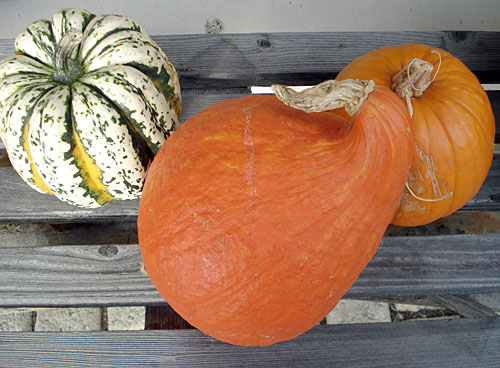
I think that winter squash is not nearly as popular as it should be. The only food-trendiness strike against it is that it's not low-carb, but in all other aspects it's so much healthier, and tastier, than their much popular summer squash relatives like zucchini. Winter squash are packed full of fiber, beta-carotenes, and other goodness. Most varieties are also deliciously sweet, and now is the season for many of them.
Perhaps winter squash isn't so popular because the most popular kind, pumpkins, are not that tasty. The flesh of pumpkins is quite bland and rather watery, with a fibrous texture - which is why it's usually only fit for doctoring up with tons of sugar and things, puréed and made into pies or turned into soup.
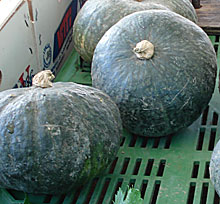 Once you get beyond pumpkins though, it gets a whole lot better. My favorite kinds are in the kabocha (the generic name for winter squash in Japanese) family. Most kabocha squashes are bright to dark green on the outside and a flattish oval in shape. The flesh inside is a bright orange or bright yellow, and very sweet and dense, like a sweet potato. In Japan, kabocha is most often eaten as a side dish, cooked in dashi stock and soy sauce, with just a little sugar if needed. You can also substitute kabocha chunks in this nikujaga (potatoes and meat) recipe, and it's a popular vegetable for tempura-style deep frying. The skin of kabocha squash is quite thin so you don't need to peel it.
Once you get beyond pumpkins though, it gets a whole lot better. My favorite kinds are in the kabocha (the generic name for winter squash in Japanese) family. Most kabocha squashes are bright to dark green on the outside and a flattish oval in shape. The flesh inside is a bright orange or bright yellow, and very sweet and dense, like a sweet potato. In Japan, kabocha is most often eaten as a side dish, cooked in dashi stock and soy sauce, with just a little sugar if needed. You can also substitute kabocha chunks in this nikujaga (potatoes and meat) recipe, and it's a popular vegetable for tempura-style deep frying. The skin of kabocha squash is quite thin so you don't need to peel it.
Another kind that has similar qualities to kabocha is called kuri squash or Hokkaido kuri. (Kuri means chestnut in Japanese, and it is sort of a chestnut shape - though I believe it refers more to its chestnut-like flesh rather than the shape.) It's the bright orange, onion-shaped one in the foreground of the photo at the top. In Switzerland and Germany it's called Knirps. Thin-skinned and a bit less sweet than kabocha, it's great for roasting, soups, and a lot else.
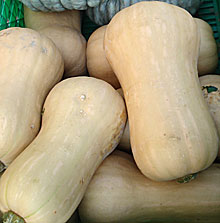 Most winter squash however have rather thick, inedible skins. These will need to be peeled if you use them in chunks. Or, bake or microwave then, then scoop out the flesh for use in soups or pies. The popular and distinctive butternut squash for instance has a pretty tough skin, so it's best to just use the flesh. Cut in half, remove the seeds (a spoon is best for this task), and place cut-side down in a baking pan with about 1/2 inch (1 cm or so) of water in it. Bake for about 45 minutes in a 350°F / 180°C, until a knife poked into it goes through without any resistance. To microwave, wrap each half in plastic wrap and nuke for about 12 to 15 minutes until tender. Scrape out the cooked flesh and mash up further for use. Other kinds of tough-skinned squash can also be treated like this.
Most winter squash however have rather thick, inedible skins. These will need to be peeled if you use them in chunks. Or, bake or microwave then, then scoop out the flesh for use in soups or pies. The popular and distinctive butternut squash for instance has a pretty tough skin, so it's best to just use the flesh. Cut in half, remove the seeds (a spoon is best for this task), and place cut-side down in a baking pan with about 1/2 inch (1 cm or so) of water in it. Bake for about 45 minutes in a 350°F / 180°C, until a knife poked into it goes through without any resistance. To microwave, wrap each half in plastic wrap and nuke for about 12 to 15 minutes until tender. Scrape out the cooked flesh and mash up further for use. Other kinds of tough-skinned squash can also be treated like this.
Incidentally, I find most huge squash to be fairly watery and tasteless, while tiny immature squash are not sweet enough. Go for the medium-sized ones.
Generally speaking, the better a "keeper" a squash is supposed to be, the tougher and thicker the skin. Blue Hubbard squash for instance has a skin that's so tough that you almost need a hatchet to cut it open. Cutting squash can be a rather scary thing - just use a sturdy knife, and go slowly. Once you've cut into it, the rest of the chopping up is a lot easier. Limiting yourself to the thinner-skinned varieties also helps. Frozen pre-cut kabocha squash is available in Japanese and Asian groceries - squash does freeze quite well. (If freezing your own, cut it up in chunks and blanch briefly.)
Following are two very easy recipes using thin-skinned kabocha type or kuri squash. (You can use thicker-skinned ones if you peel the skin.)
[Update:] also check out this creamy kuri squash pudding with apples, flavored with maple syrup - it's even vegan!
Roasted winter squash with feta cheese
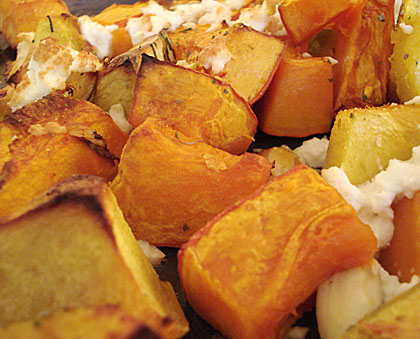
This is a super-easy and fast vegetarian one-dish meal. The feta does not really melt, it just sort of relaxes, and the saltiness of it contrasts perfectly with the sweet squash.
- About 4 cups of cut-up squash, peeled if from a tough-skin kind
- 4 cloves garlic
- 1 cup (or more, to taste) feta cheese, crumbled
- 1 tsp. dried thyme
- Salt and pepper
- Olive oil
Preheat the oven to 400°F / 200°C.
Peel and very roughly chop the garlic.
Toss together all the ingredients except for the cheese in a bowl until all is coated with the oil and the seasonings. Spread in one layer on a baking sheet. Bake, covered with foil, for about 30 minutes.
Remove the foil and sprinkle the feta cheese on top. Bake for another 10-15 minutes until the squash is tender (poke with knife) and the top is a tiny bit browned. (The feta will not change color much.) Serve immediately. .
Winter squash with crême fraiche and honey
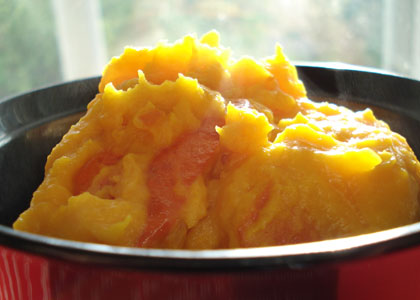
This may sound like a dessert, and you can eat it as dessert if you like. But it's also a great side dish, for roast pork, roast lamb and so on. The cinnamon and cayenne add just a bit of zing that brings it all together. I could eat bowlfuls of this.
- About 4 cups of cut-up kabocha or kuri squash (here I used the orange-skinned Knirps, or kuri squash kind)
- 1 cup crême fraiche
- 3 Tbs. honey
- 1/4 tsp (or a pinch) each of cinnamon and cayenne pepper
- 1 tsp. salt
Put the cut-up squash into a pan and cover with water. Bring to a boil and simmer until the squash is tender, about 15-20 minutes. Drain the water.
Put the squash back in the pan. Add the crême fraiche, honey, and salt. Stir gently and simmer for another 5 minutes. Add the cinnamon and cayenne; mix well. (It will disintegrate somewhat, don't worry about it.) Serve while hot. This also re-heats in the microwave very well, and leaving it in the fridge for a day deepens the flavors.
If you enjoyed this article, please consider becoming my patron via Patreon. ^_^

 Welcome to Just Hungry, where we serve authentic Japanese recipes and more! I'm
Welcome to Just Hungry, where we serve authentic Japanese recipes and more! I'm 













Comments
Garrett
11 October, 2006 - 20:45
Permalink
Produce: Winter squash and pumpkins
Mmm, the cheese dish looks great! I just made butternut squash cupcakes, and I have an extra one sitting around. I'll have to try this out!
Michael
16 October, 2006 - 12:38
Permalink
Produce: Winter squash and pumpkins
Thank you so much for this article. As an American living in Tokyo I frequently see kabocha in the supermarket but am never sure on how to prepare it. I hope to try both of these recipes, as well as your recommendation for substituting it in nikujaga, soon.
anon.
3 September, 2009 - 15:22
Permalink
Re: Produce: Winter squash and pumpkins
i buy the frozen kabocha from Japanese supermarket and just eat it for breakfast. A wweet and delicious way to start the morning.
Annabel
5 September, 2009 - 22:19
Permalink
Re: Produce: Winter squash and pumpkins
MMmMmm... Autumn is my favourite season of the year, not just because of the brilliant colours all around but also for the pumpkins and squash available! I unfortunately don't know enough ways to cook pumpkins and certainly don't know how to pick them... namely I don't know which ones stay firm (like butternuts) and which ones fall apart into fibrous watery strands (like most pumpkins I end up buying). So thanks for the recipes and thanks for letting me know which types I should be buying :)
anon.
5 October, 2009 - 05:56
Permalink
Re: Produce: Winter squash and pumpkins
Thanks for this article.
Is it better to buy organic or is it OK to stick with the non-organic ones? Are squashes sprayed with pesticides?
Tks